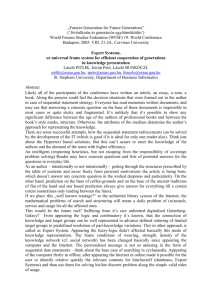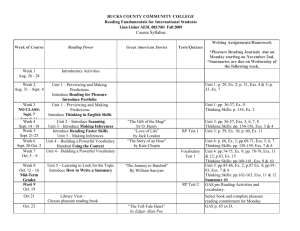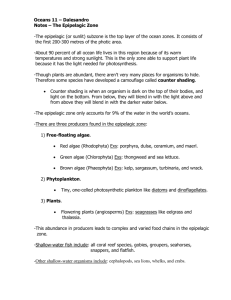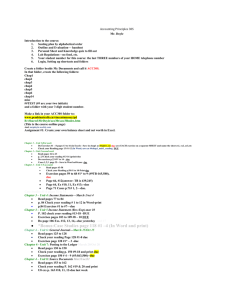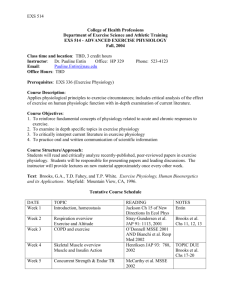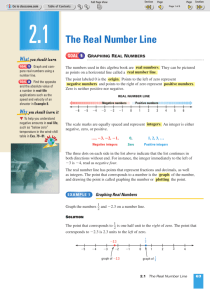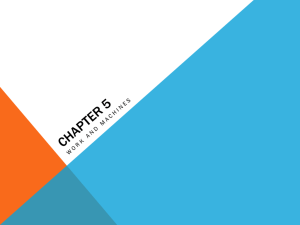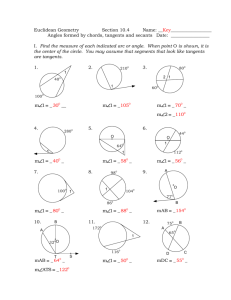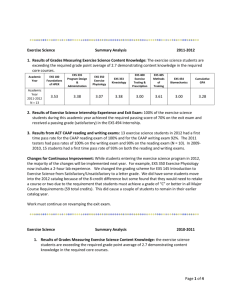Exercise Science Changes for Improvement 2012
advertisement
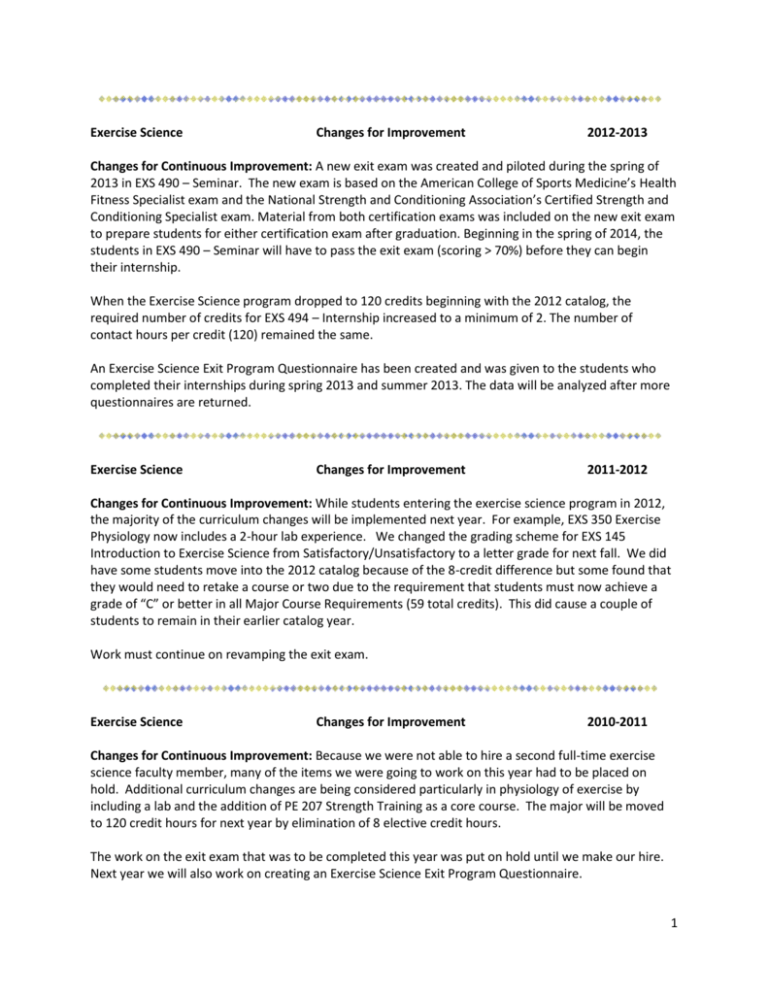
Exercise Science Changes for Improvement 2012-2013 Changes for Continuous Improvement: A new exit exam was created and piloted during the spring of 2013 in EXS 490 – Seminar. The new exam is based on the American College of Sports Medicine’s Health Fitness Specialist exam and the National Strength and Conditioning Association’s Certified Strength and Conditioning Specialist exam. Material from both certification exams was included on the new exit exam to prepare students for either certification exam after graduation. Beginning in the spring of 2014, the students in EXS 490 – Seminar will have to pass the exit exam (scoring > 70%) before they can begin their internship. When the Exercise Science program dropped to 120 credits beginning with the 2012 catalog, the required number of credits for EXS 494 – Internship increased to a minimum of 2. The number of contact hours per credit (120) remained the same. An Exercise Science Exit Program Questionnaire has been created and was given to the students who completed their internships during spring 2013 and summer 2013. The data will be analyzed after more questionnaires are returned. Exercise Science Changes for Improvement 2011-2012 Changes for Continuous Improvement: While students entering the exercise science program in 2012, the majority of the curriculum changes will be implemented next year. For example, EXS 350 Exercise Physiology now includes a 2-hour lab experience. We changed the grading scheme for EXS 145 Introduction to Exercise Science from Satisfactory/Unsatisfactory to a letter grade for next fall. We did have some students move into the 2012 catalog because of the 8-credit difference but some found that they would need to retake a course or two due to the requirement that students must now achieve a grade of “C” or better in all Major Course Requirements (59 total credits). This did cause a couple of students to remain in their earlier catalog year. Work must continue on revamping the exit exam. Exercise Science Changes for Improvement 2010-2011 Changes for Continuous Improvement: Because we were not able to hire a second full-time exercise science faculty member, many of the items we were going to work on this year had to be placed on hold. Additional curriculum changes are being considered particularly in physiology of exercise by including a lab and the addition of PE 207 Strength Training as a core course. The major will be moved to 120 credit hours for next year by elimination of 8 elective credit hours. The work on the exit exam that was to be completed this year was put on hold until we make our hire. Next year we will also work on creating an Exercise Science Exit Program Questionnaire. 1 Exercise Science Changes for Improvement 2008-2010 1. Changes for Continuous Improvement: Beginning academic year 2011 – 2012, all data, with the exception of the CAAP scores, will reflect only the graduates in that particular cohort rather than all students taking the course(s) that particular semester or year. This should give a better picture of that group of graduates and provide more consistency as the data is reviewed. Considerable work was done with the exercise science curriculum including changing course names 1) EXS 335 Program Design & Administration to Administration of Exercise Science; 2) EXS 405 Methods of Training to Physiological Methods of Training; 3) EXS 420 Facility Risk Management to Risk Management. EXS 490 Senior Seminar for 2 credits was added to the curriculum to assist students with internship preparation, writing a resume and letter of application, preparation for the national Certified Strength and Conditioning Specialist (CSCS) exam and graduate school preparation. Another major change included eliminating the list of Major Electives and moving to Free Electives. Because this major has a diverse group of student interests (personal training to physical therapy), students and their advisor will be better able to choose classes that will be more appropriate to their career goals and will decrease significantly the number of substitutions needed. Another major change included adding prerequisite courses: 1) EXS 350 Exercise Physiology (BIOL 221 Human Anatomy w/Lab); EXS 353 Kinesiology (BIOL 221 Human Anatomy w/Lab); EXS 395 Practicum (EXS 350 Exercise Physiology & 400 Exercise Testing & Prescription); EXS 400 Exercise Testing & Prescription (EXS 350 Exercise Physiology, EXS 353 Kinesiology & PE 354 Prevention & Care of Athletic Injuries); EXS 405 Physiological Methods of Training (EXS 350 Exercise Physiology); EXS 454 Biomechanics (BIOL 221Human Anatomy w/Lab & EXS 353 Kinesiology); and EXS 490 Senior Seminar (prerequisite of Senior Standing). A grade of C or better is required in the following courses: EXS 180 Foundations of HPER; EXS 350 Exercise Physiology; EXS 353 Kinesiology; EXS 400 Exercise Testing & Prescription; and EXS 454 Biomechanics. To make it easier for students to follow, a new checksheet was created that includes a Sample Schedule as well as listing prerequisites needed for courses and which semester courses are offered. Considerable work was done in revamping the exercise science internship evaluations and exit exam to more closely align it to the CSCS certification exam. While there is no movement to require students to take the CSCS exam, it is our intent to track students who take the exam so that we may review the data and see if additional changes are needed. At this time there is not enough data for the revised exit exam or revised internship evaluations (only spring 2010) to draw any conclusions. Work has not yet begun on creating an Exit Program Questionnaire. Exercise Science Changes for Improvement 2006-2008 1. Changes for Continuous Improvement: This year, 2008-2009, will be a year of reviewing the entire exercise science program, including assessment measures, goals, outcomes and alignment/accreditation to the National Strength and Conditioning Association. Therefore, curriculum changes will more than likely occur. 2 Because of the substantial enrollment increases in this program over the last five years, a new faculty member was hired. He brings added expertise and strength in research to the program and has been a part of program accreditation in his prior position. Return rates for both graduate and employer surveys were low and therefore not usable; faculty will review the survey questions and work to increase survey return rates. Prior to this semester, scores for the exercise science exit exam have not been recorded into any database. We will begin the process with the fall 2008 testers. Additionally, two readers will now evaluate each student’s exam whereas in the last 3 years, there has been only one evaluator. With the alignment to a national association, the exit exam will need to be reviewed for possible changes needed to measure student’s knowledge and skills. 3

